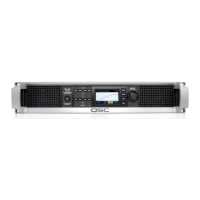PLD Series Amplifiers 11
Application Guide—Portable PA Rev. E, Apr. 2015
When the current
waveform is a sine
that coincides exact-
ly with the voltage
waveform, the load on
the AC mains appears
linear and resistive.
Efficiency
PLD Series power amps are kind to the AC mains in another important way: electrical efficiency, or the ratio of output
power to the power drawn from the AC mains. The dynamic nature of audio and its frequency range spanning some ten
octaves has always made it very difficult to achive very good efficiency in power amps. Any power that comes in on the
power cable that doesn’t go out through the loudspeaker cables is wasted and turns into heat. Low efficiency not only
limits how large an audio system you can use with a given level of electrical service, but also results in greater size, weight,
and cost, largely because of the increased needs for output devices, heat sinks, fan, etc. Power amp designers developed
and refined Class AB, Class G, and Class H technologies to help improve electical efficiency.
But Class D—a radically different method of amplification—has truly revolutionized the quest for efficiency. Instead of using
the audio signal to modulate a voltage across output transistors, which is inherently lossy, Class D converts the varying
amplitude of the signal into a pulse-width-modulated stream, where the time duration of the pulses are proportional to
the value of the signal. The pulse stream switches the output transistors fully on and off, so they dissipate very little power
even at high output levels. A passive network of inductors and capacitors smooths out the pulses to reconstruct the audio
signal.
The PLD4.3 and PLD4.5 amplifers use a custom proprietary dual output transistor device on each channel, which compris-
es a precisely matched pair of MOSFET dies. These are tightly integrated into the design of the amplifier’s modulator and
yield exceptionally good audio performance and extremely high efficiency. This also is why we can fit four high-power amp
channels into a lightweight two-rack-space package!
Truly universal voltage
Historically, QSC power amps have been manufactured to operate on a specific mains voltage: 100 volts (Japan), 120
volts (primarily North America and some parts of South America), and 230 volts (Europe, Africa, most of Asia, and parts
of South America). This was not much of a problem if all of your production activities were within a region served by the
same voltage, but in many cases users who worked internationally or even in countries where multiple mains voltages are
in common usage found it a hassle to use heavy-duty step-up or step-down transformers.
The PLD Series amplifers use power supplies with truly universal voltage ability. Unlike some “universal” power supplies
that work in a given range above and below 120 volts and another given range above and below 230 volts but behave
erratically at voltages in between, the PLD power supplies adapt fully and seamlessly to any AC mains voltage from 90 to
260 volts.

